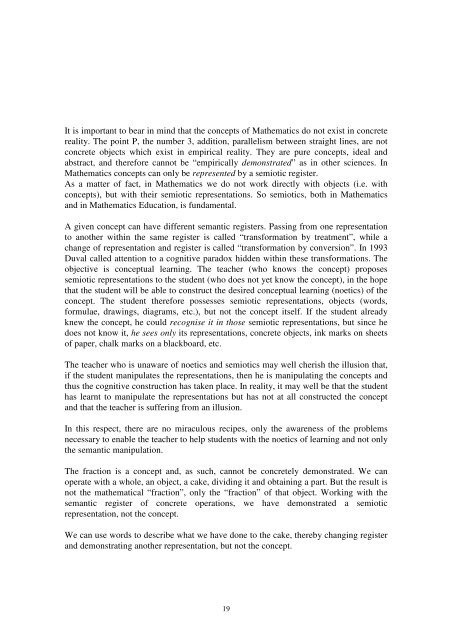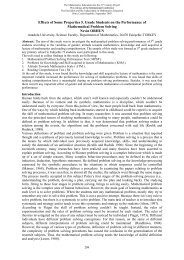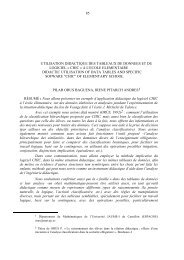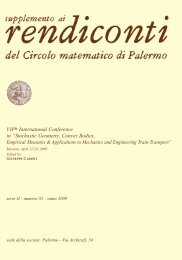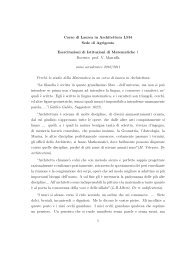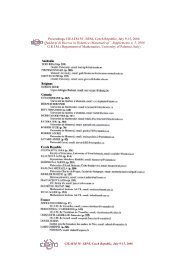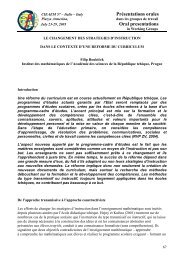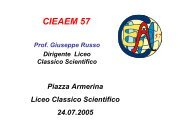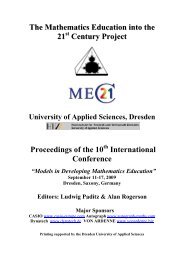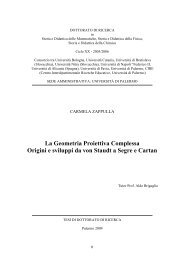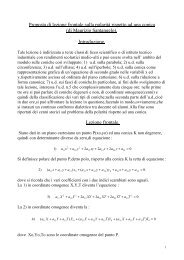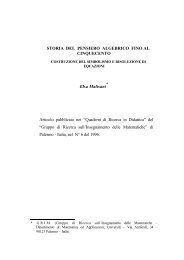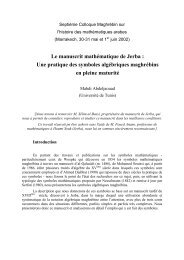CONTENTS - Dipartimento di Matematica e Informatica
CONTENTS - Dipartimento di Matematica e Informatica
CONTENTS - Dipartimento di Matematica e Informatica
Create successful ePaper yourself
Turn your PDF publications into a flip-book with our unique Google optimized e-Paper software.
It is important to bear in mind that the concepts of Mathematics do not exist in concrete<br />
reality. The point P, the number 3, ad<strong>di</strong>tion, parallelism between straight lines, are not<br />
concrete objects which exist in empirical reality. They are pure concepts, ideal and<br />
abstract, and therefore cannot be “empirically demonstrated” as in other sciences. In<br />
Mathematics concepts can only be represented by a semiotic register.<br />
As a matter of fact, in Mathematics we do not work <strong>di</strong>rectly with objects (i.e. with<br />
concepts), but with their semiotic representations. So semiotics, both in Mathematics<br />
and in Mathematics Education, is fundamental.<br />
A given concept can have <strong>di</strong>fferent semantic registers. Passing from one representation<br />
to another within the same register is called “transformation by treatment”, while a<br />
change of representation and register is called “transformation by conversion”. In 1993<br />
Duval called attention to a cognitive paradox hidden within these transformations. The<br />
objective is conceptual learning. The teacher (who knows the concept) proposes<br />
semiotic representations to the student (who does not yet know the concept), in the hope<br />
that the student will be able to construct the desired conceptual learning (noetics) of the<br />
concept. The student therefore possesses semiotic representations, objects (words,<br />
formulae, drawings, <strong>di</strong>agrams, etc.), but not the concept itself. If the student already<br />
knew the concept, he could recognise it in those semiotic representations, but since he<br />
does not know it, he sees only its representations, concrete objects, ink marks on sheets<br />
of paper, chalk marks on a blackboard, etc.<br />
The teacher who is unaware of noetics and semiotics may well cherish the illusion that,<br />
if the student manipulates the representations, then he is manipulating the concepts and<br />
thus the cognitive construction has taken place. In reality, it may well be that the student<br />
has learnt to manipulate the representations but has not at all constructed the concept<br />
and that the teacher is suffering from an illusion.<br />
In this respect, there are no miraculous recipes, only the awareness of the problems<br />
necessary to enable the teacher to help students with the noetics of learning and not only<br />
the semantic manipulation.<br />
The fraction is a concept and, as such, cannot be concretely demonstrated. We can<br />
operate with a whole, an object, a cake, <strong>di</strong>vi<strong>di</strong>ng it and obtaining a part. But the result is<br />
not the mathematical “fraction”, only the “fraction” of that object. Working with the<br />
semantic register of concrete operations, we have demonstrated a semiotic<br />
representation, not the concept.<br />
We can use words to describe what we have done to the cake, thereby changing register<br />
and demonstrating another representation, but not the concept.<br />
19


